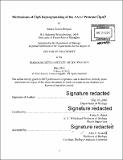| dc.contributor.advisor | Tania A. Baker. | en_US |
| dc.contributor.author | Torres-Delgado, Amaris | en_US |
| dc.contributor.other | Massachusetts Institute of Technology. Department of Biology. | en_US |
| dc.date.accessioned | 2016-09-13T19:09:06Z | |
| dc.date.available | 2016-09-13T19:09:06Z | |
| dc.date.copyright | 2016 | en_US |
| dc.date.issued | 2016 | en_US |
| dc.identifier.uri | http://hdl.handle.net/1721.1/104178 | |
| dc.description | Thesis: Ph. D., Massachusetts Institute of Technology, Department of Biology, 2016. | en_US |
| dc.description | Cataloged from student-submitted PDF version of thesis. Page 87 blank. | en_US |
| dc.description | Includes bibliographical references (pages 76-86). | en_US |
| dc.description.abstract | The proteome of a cell needs to be constantly modified for protein quality control and to respond to environmental and developmental changes. Energy-dependent proteases are key to ensuring the proper composition of the proteome in all kingdoms of life. Because of the irreversible nature of protein destruction, substrates need to be chosen with high accuracy. This selection is achieved in part by the architecture of these proteases, as they have their proteolytic sites sequestered in a chamber inaccessible to the cytosol. As a consequence, folded proteins need to be denatured and translocated into this chamber for degradation to occur. These peptidase chambers can partner with AAA+ (ATPases Associated with various cellular Activities) unfoldases, protein machines that control substrate access to this chamber. An additional level of control is provided by adaptor proteins, which modulate substrate selection by the AAA+ enzymes. I characterized the mechanisms by which the E. coli ClpS adaptor protein regulates substrate degradation by its cognate AAA+ protease, ClpAP. I focused my studies on how ClpS inhibits degradation of the ssrA class of substrates while efficiently enhancing degradation of the N-degron substrate class. I elucidated two strategies that ClpS employs to reprogram ClpA's substrate preference. CIpS weakens, but does not prevent ssrA substrate binding. ClpA, CIpS and ssrA substrate form a ternary complex that is part of the degradation pathway. ClpS also alters the catalytic steps ClpAP employs during ssrA substrate degradation. I report evidence demonstrating that suppression of ClpAP's ATPase rate by CIpS is part of the mechanism by which ClpS inhibits ClpAP's mechanical activities. Finally, I provide completing data establishing that the substrate translocation step directly targeted for CIpS inhibition. In addition to probing CIpS mechanism, I also dissected the structural features of CIpS required for inhibition. I demonstrate that the unstructured N-terminal extension of ClpS is both necessary and sufficient to inhibit substrate degradation. Engagement of this NTE by the ClpA translocation pore is critical for CIpS-mediated inhibition. I propose a model where ClpS behaves as a substrate mimic to modulate both substrate recognition and processing. Other adaptors that regulate catalysis and substrate choice of their partner AAA+ enzymes may employ features of this model. | en_US |
| dc.description.statementofresponsibility | by Amaris Torres-Delgado. | en_US |
| dc.format.extent | 87 pages | en_US |
| dc.language.iso | eng | en_US |
| dc.publisher | Massachusetts Institute of Technology | en_US |
| dc.rights | M.I.T. theses are protected by copyright. They may be viewed from this source for any purpose, but reproduction or distribution in any format is prohibited without written permission. See provided URL for inquiries about permission. | en_US |
| dc.rights.uri | http://dspace.mit.edu/handle/1721.1/7582 | en_US |
| dc.subject | Biology. | en_US |
| dc.title | Mechanisms of CipS reprogramming of the AAA+ protease CipAP | en_US |
| dc.type | Thesis | en_US |
| dc.description.degree | Ph. D. | en_US |
| dc.contributor.department | Massachusetts Institute of Technology. Department of Biology | |
| dc.identifier.oclc | 958133916 | en_US |
